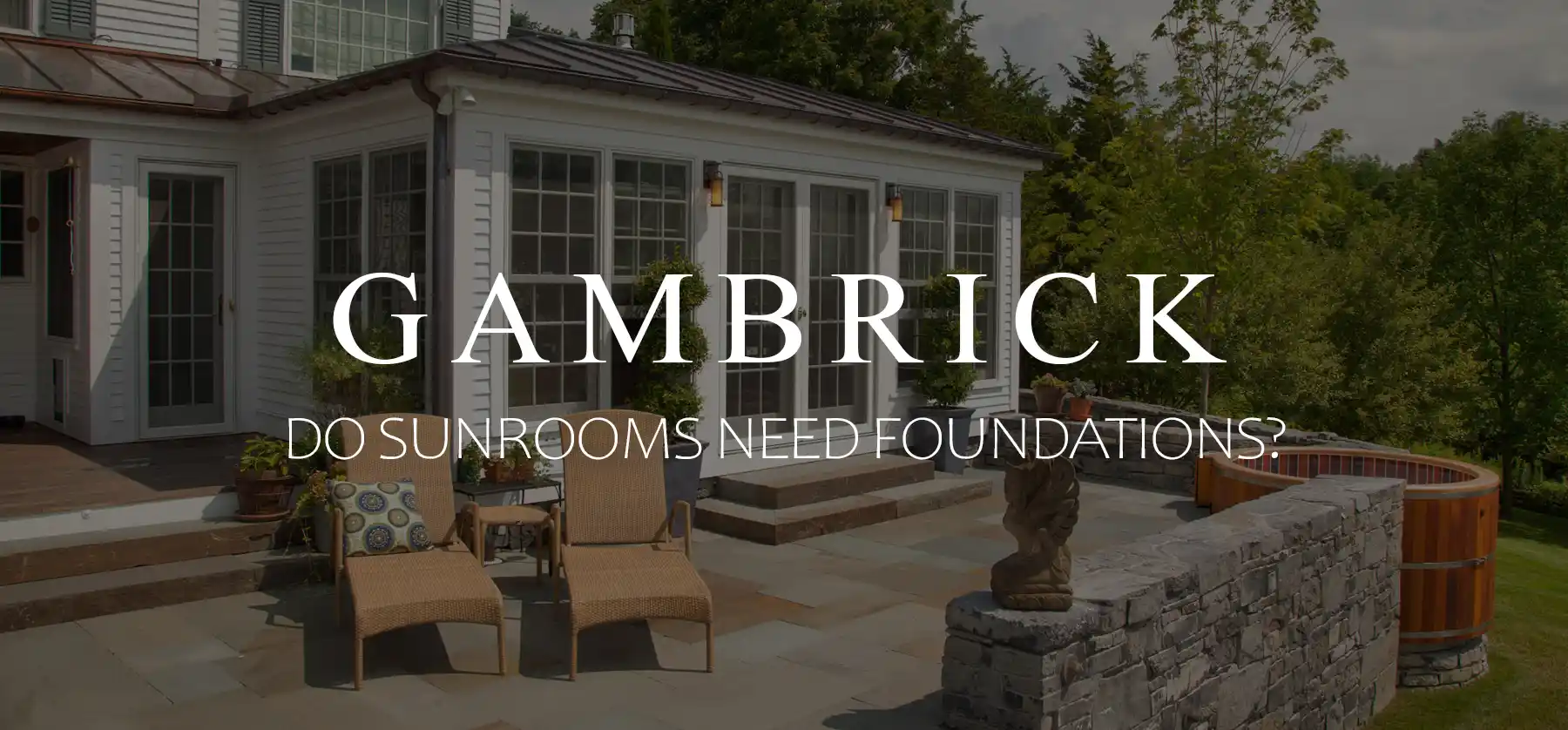
Do Sunrooms Need Foundations?

By John Mazzuca | About | More Posts |
John Mazzuca is a custom home builder with over 25 years experience in the construction industry. John has designed, managed, and built hundreds of homes & construction projects.
Sunrooms, like any structural addition to a home, require a foundation. The foundation provides stability, prevents settling, and ensures that the sunroom is properly anchored to the ground. The type of foundation needed for a sunroom can vary based on factors like the design, the existing home structure, local building codes, and the geographical location.
I’ve been a NJ sunroom contractor for over 25 years and can tell you firsthand how important a foundation is. It bears the weight of the structure and withstands environmental stresses such as wind, rain, and snow.
In colder climates, a foundation must be deep enough to reach below the frost line to prevent the sunroom from shifting due to freeze-thaw cycles. This typically means pouring a concrete footing or using piers that extend to the appropriate depth.
In more temperate climates, a shallower foundation or even a reinforced deck structure might suffice. But it must be able to support the weight of the sunroom and meet local building requirements.
Local building codes and regulations play a significant role in determining how sunrooms are built. Consult with local authorities and obtain the necessary permits before construction begins.
The foundation type can also affect the sunroom’s functionality and cost. A more substantial foundation, like a full basement or crawl space, can provide additional storage or utility space but will increase the overall cost and complexity of the project. On the other hand, a slab-on-grade foundation might be more cost-effective and quicker to install but offers less protection against the cold and no additional space.
While the specific foundation requirements for a sunroom can vary, the need for a foundation is almost universal. A properly built foundation ensures the sunroom is safe, stable, and compliant with local building standards.
What Type Of Foundation Do You Need For A Sunroom?
A sunroom needs a concrete foundation to support its weight, keep it stable, and prevent it from settling. The most common types are slab-on-grade, a crawl space, and a full basement.
Sunrooms can be quite heavy because of all the windows that are included in their construction, especially if they include operable windows. A window unit that opens and closes can be over 5 times heavier than a standard wall.
The type of foundation that’s best largely depends on the sunroom’s design, the local climate, soil conditions, and local building codes.
Slab-on-Grade
This is the most straightforward foundation type for a sunroom. It involves pouring a concrete slab directly on the ground. The slab must be level and may need to be reinforced with steel, depending on the size of the sunroom and the soil conditions. Slab-on-grade is cost-effective and suitable for climates where the ground doesn’t freeze, as frost heave can crack the slab.
- The benefits of a slab-on-grade foundation are a lower cost and a quicker installation, which also saves money. Once the concrete has cured, construction can begin within days. This is ideal for projects on a tight schedule.
- A slab foundation requires minimal maintenance over time, without the need for the ongoing moisture control that basements and crawlspaces often demand.
Despite these advantages, there are some drawbacks to keep in mind.
- In climates where the ground freezes, a slab-on-grade foundation is susceptible to shifting and cracking due to frost heave. The expanding and contracting soil can exert pressure on the concrete, potentially leading to structural issues.
- A slab foundation doesn’t provide the same easy access to plumbing and electrical systems that a basement or crawlspace does, which can complicate future repairs or modifications.
- It also doesn’t typically have as much insulation as a basement or crawl space, which is an issue in colder climates.
A slab-on-grade foundation can be an excellent choice for a sunroom because it’s fast and inexpensive. But consider the local climate conditions, soil stability, and the specific design of the sunroom, because there are a few drawbacks.
Crawlspace
A crawlspace foundation raises the sunroom off the ground, typically by several feet, using a perimeter wall of poured concrete or concrete block with a footing below the frost line. This type of foundation can provide a small space for utilities and extra insulation from cold weather. It’s a good middle-ground option that can work in a variety of climates, including those with freeze-thaw cycles.
A crawl space is a very good option in especially damp areas. The elevation allows for better air circulation, which helps to keep the floor of the sunroom dry and insulated against cold and moisture from the ground.
Because a crawl space elevates the sunroom, it’s easier to access plumbing, electrical, ductwork, and insulation. This can be a huge advantage vs. slabs if you need to make repairs or upgrades to the addition. The added height also provides some protection against flooding, which is a huge benefit here at the Jersey Shore.
Crawl spaces can have drawbacks, such as the potential for moisture accumulation, which can lead to mold growth and wood rot if not properly managed. The construction of a crawl space foundation is more costly and time-consuming than a slab-on-grade due to the need for excavation and the construction of the foundation walls.
A crawl space foundation can offer practical benefits for a sunroom, particularly in terms of maintenance and insulation. However, these advantages come with increased complexity and cost, as well as the need for careful moisture management.
Basement
A full basement foundation is the most substantial and usually the most expensive option for a sunroom. It involves creating a complete underground space beneath the sunroom, which not only supports the structure but also adds additional living or storage space. This type of foundation is ideal for cold climates because it places the foundation below the frost line, protecting it from freezing temperatures.
By extending below the frost line, a basement foundation ensures that the sunroom is anchored on a stable base, reducing the risk of damage from freeze-thaw cycles. It’s especially good in colder climates where deep frost penetration can affect shallower foundations.
The thermal mass of the earth surrounding a basement provides natural insulation, contributing to a more consistent temperature in the sunroom. This insulation effect can make the sunroom more comfortable to use year-round and more energy-efficient.
However, there are drawbacks to consider. The construction of a basement foundation is typically the most expensive option due to the extensive excavation required, the need for more complex structural supports, and the potential for waterproofing and insulation to prevent moisture problems.
Building a basement is the most time-consuming option, which can extend the overall construction timeline of the sunroom by over a month.
While a basement foundation can enhance the utility and stability of a sunroom, it comes with higher initial costs and complexity. The decision to opt for a basement foundation should be weighed against these factors, as well as the homeowner’s budget and long-term plans for the space.
Piers, Pilings, & Columns
A pier foundation for a sunroom consists of cylindrical concrete columns, wood pilings, or concrete block columns that are placed deep into the ground, acting as a support for the structure above. This type of foundation is great for uneven terrain, flood-prone areas, or sites where traditional excavation and laying of a full foundation are impractical or too costly.
Piers can be strategically placed to minimize the impact on the surrounding landscape, making this a good choice for environmentally sensitive areas.
The elevated nature of a pier foundation allows for excellent airflow beneath the sunroom, which can prevent moisture accumulation and the resultant issues such as mold and wood rot.
It’s also beneficial in regions prone to flooding, as it raises the sunroom above any potential water level. The construction of a pier foundation can be less invasive and quicker to install compared to a full basement or crawlspace foundation, potentially reducing the time it takes to build.
However, pier foundations do have some drawbacks. They may not be as stable as full foundations in seismic zones and can be susceptible to shifting if not properly installed.
In terms of cost, pier foundations can be more economical than full basements or crawlspaces but are more expensive than a slab. The final expense can vary based on the complexity of the installation and the number of piers required.
Can A Sunroom Be Built On A Concrete Patio?
A sunroom can be built on a concrete patio, provided that the patio is structurally sound and meets certain conditions. The concrete patio must be able to support the weight of the sunroom. This includes the structure itself, any furniture, and occupants. An inspection by a structural engineer or architect can determine if the patio’s thickness and reinforcement are adequate.
The type of sunroom you plan to build will determine whether or not a patio can be used. Simple, light-weight sunroom kits can usually be built atop a patio. But heavier, more complex sunroom additions usually need a full concrete foundation and footings.
Here are a few tips to consider:
- The patio should be level to ensure the sunroom is constructed properly.
- Cracks or damage in the concrete could indicate underlying issues that need to be addressed before construction.
- Local building codes may require a foundation that extends below the frost line to prevent shifting from freeze-thaw cycles. If the patio doesn’t meet these requirements, modifications might be necessary.
- Proper drainage is crucial to prevent water from pooling around the sunroom’s base. This could lead to damage in the future. The patio should be designed to direct water away from the structure.
- Always check with local building authorities to obtain necessary permits. Make sure construction complies with all relevant codes and regulations.
If the existing patio meets these requirements, it can be a great foundation for a sunroom. They can offer a solid and level base that’s already integrated into the landscape of the property. However, if the patio isn’t up to standard, it may need to be reinforced or replaced.
Do You Need A Foundation For A Three Season Room?
Yes, a three-season room, much like any other structural addition to a home, requires a foundation. The foundation supports the structure, ensuring it’s level, stable, and secure. The specific type of foundation needed can vary based on several factors, including the design of the room, the local climate, the terrain, and the existing structure of the home.
The type of three-season room affects the type of foundation that’s needed. Some simple, light-weight three-season sunroom kits can be built on an existing patio. But full-blown sunroom additions need a full foundation for support.
A three-season room’s foundation usually doesn’t have to be as robust as a four-season room because they’re not insulated. A four-season room requires and insulated floor, which increases the complexity of the foundation.
Common foundation options for a three-season room include:
- Slab-on-Grade: A popular choice for its simplicity and cost-effectiveness, especially in climates without deep frost lines.
- Crawl Space: Offers the benefit of elevation from the ground, which can help with insulation and moisture control.
- Pier and Beam: A good option for uneven terrain or for minimizing the impact on the surrounding area.
Regardless of the type you choose, the foundation must comply with local building codes and regulations. They usually dictate certain requirements based on the region’s climate and soil conditions.
How Deep Should Footings Be For A Sunroom?
How deep the footings for a sunroom should be is primarily determined by the local climate, specifically the frost line, which is the depth to which the ground freezes in the winter. Footings should extend below the frost line to prevent the structure from being affected by frost heave. This occurs when the ground expands upon freezing and can cause the foundation to move and crack.
In many regions, this means the footings should be at least 30 to 48 inches deep. This is a common range for frost lines in a variety of climates. As a general rule of thumb, I always dig my footings at least 36 to 40 inches deep.
The exact footing depth can vary significantly depending on the climate and region.
In very cold climates, the frost line can be deeper, requiring footings to extend perhaps several feet below the surface. But in warmer climates where the ground doesn’t freeze, footings may not need to be as deep, but should still be sufficient to anchor the structure and support the weight of the sunroom.
Local building codes will provide the specific requirements for footing depths in your area. It’s important to follow these regulations to ensure the stability and legality of your sunroom.
Can A Sunroom Be Built On A Deck?
A sunroom can be built on a deck, but it must be structurally sound and capable of supporting the additional weight of the sunroom. This includes the framing, glass, roofing, and any furnishings that will occupy the space.
Whether or not a deck can support a sunroom depends on the room you plan on building. A full sunroom addition with framed walls and roof weighs a lot more than a simple sunroom kit. The heavier and more complex the sunroom, the greater the demand on the deck.
The deck’s foundation and framing should be assessed by a structural engineer or an architect to determine if they meet the necessary specifications. This assessment includes checking that the footings are set below the frost line to prevent shifting during freeze-thaw cycles, and that the framing has the required strength and stability.
If the existing deck doesn’t meet these standards, it may need to be reinforced or even replaced with a more robust structure.
Local building codes and permits must be considered. Building a sunroom on a deck requires a permit, and the construction must adhere to local building regulations. These can include specific requirements for foundations, structural support, and materials.
While it’s possible to build a sunroom on a deck, the feasibility depends on the existing deck’s condition, the structure you plan on building, and compliance with local building codes.
If you have any questions or comments email or leave a comment down below.

John Mazzuca | About | More Posts |
Custom Home Builder
John Mazzuca is a custom home designer and builder at Gambrick with over 25 years experience in the construction industry. John has designed, built and/or remodeled hundreds of homes, small buildings, and commercial projects. He writes about business, real estate, home building, and household electronics. His work has been featured in Fox Business, Better Homes & Garden, House Beautiful, and more.




















